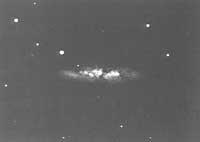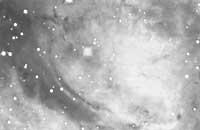Wind of galaxies

We return to give another detail of our galaxy; as in other cases, the detail that other spiral galaxies present. Of course, the problems to be investigated are still many and very important, but on this occasion we are going to take care of one who has obtained confirmation of the observations recently, although it is not yet clear.
Speaking of the Sun and the Solar System, we have often mentioned the solar wind, the flow of fractions emitted by our star. In general we can talk about the stellar wind and talk about such a problem in the article dedicated to the limits of the Solar System. Moving to the level of galaxies it is logical to discuss the problem of the existence of the galaxi wind. This wind would be the flow of fractions produced by violent phenomena occurring in the nucleus of the galaxy and would expand through it in the form of a ring.
It seems that what until now was only a theoretical conjecture has been confirmed experimentally. Two researchers from the Astrophysical Institute of the Canary Islands, John Beckman and Casiana Muñoz, have confirmed, through observations made with the Newton telescope, the existence of the aforementioned galactic wind. The claim has been obtained in the galaxy NGC 6946. It has measured the speed of the wind that spreads to the outside of the area, reaching a speed of 120 km/s. This experimental claim has led researchers to propose an evolution model for spiral galaxies.
In his opinion, the high density of mates in the nuclei of spiral galaxies produces a high production of stars. At the same time, supernovae occur at a dizzying pace. The galactic wind is the stellar wind that occurs when nuclear reactions begin in the process of star formation and when the star is completely lit, and the matter that is thrown into space as a consequence of the explosions of supernovae, which drag the gas from the nucleus. This wind thrust would affect another experimental affirmation procedure: increasing the density of the wind generated flow around the core. The latter would favor the formation of stars forming a ring in this region around the core.

As we said, this ring has been seen in spiral galaxies, such as NGC 4736, where it has been measured to expand to 50 km/s. The radius of the ring is much larger in this galaxy that we have just mentioned than the previous NGC 6946, and is much larger than that found in the galaxy NGC 7331, in this case without radial velocity. Consequently, we could talk about a temporary sequence, if these three galaxies were in different evolutionary states. The process would begin with the wind from the core forming a static ring at the end. This evolution would also be slower in S-type spiral galaxies than in S-type galaxies, as the mass of galaxies drops in the same direction. However, if there is a reduced stay time, we could talk about 100 million years.
If this theory were valid, the rings seen so far in galaxies should not be considered as a special case, but as a consequence of their dynamics. Almost 40 years ago, a ring was also discovered through radio telescopes. This ring of arms is about 20,000 light years from the center and its expansion speed is 30 km/s. We can say, therefore, that it will continue to grow, but we cannot give a more detailed picture of its evolution.
EPHEMERISSUN May 21 enters Gemini 13h 20min.
PLANETS
|





